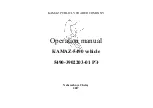
WARNING!
If the engine stalls or you lose headway or cannot
make it to the top of a steep hill or grade, never attempt
to turn around. To do so may result in tipping and
rolling the vehicle, which may result in severe injury.
Always back carefully straight down a hill in RE-
VERSE. Never back down a hill in NEUTRAL using
only the vehicle brakes. Never drive diagonally across
a hill, always drive straight up or down.
Driving Through Water
Extreme care should be taken crossing any type of water.
Water crossings should be avoided if possible and only be
attempted when necessary, in a safe responsible manner.
You should only drive through areas which are designated
and approved. You should tread lightly and avoid damage
to the environment. You should know your vehicle’s
abilities and be able to recover it if something goes wrong.
You should never stop or shut a vehicle off when crossing
deep water unless you ingested water into the engine air
intake. If the engine stalls do not attempt to restart it.
Determine if it has ingested water first. The key to any
crossing is low and slow. You want to use first gear in 4L
(Low Range) and proceed very slowly with a constant slow
speed (3-5 mph [5–8 km/h] maximum) and light throttle.
Keep the vehicle moving; do not try to accelerate through
the crossing. After crossing any water higher than the
bottom of the axle differentials, you should inspect all of
the vehicle fluids for signs of water ingestion.
CAUTION!
Water ingestion into the axles, transmission, transfer
case, engine or vehicle interior can occur if you drive
too fast or through too deep of water. Water can cause
permanent damage to engine, driveline or other ve-
hicle components and your brakes will be less effec-
tive once wet and/or muddy.
•
Before You Cross Any Type Of Water
– As you ap-
proach any type of water you need to determine if you
can cross it safely and responsibly. If necessary, get out
and walk through the water or probe it with a stick. You
need to be sure of its depth, approach angle, current and
bottom condition. Be careful of murky or muddy waters,
check for hidden obstacles. Make sure you will not be
intruding on any wildlife and you can recover the
vehicle if necessary. The key to a safe crossing is the
water depth, current and bottom conditions. On soft
5
STARTING AND OPERATING
449
Summary of Contents for RAM 1500 2017
Page 4: ......
Page 7: ...1 INTRODUCTION 5 ...
Page 10: ......
Page 157: ...Slow Tone Fast Tone 3 UNDERSTANDING THE FEATURES OF YOUR VEHICLE 155 ...
Page 228: ......
Page 332: ...8 4 8 4 NAV With Manual Temperature Controls 330 UNDERSTANDING YOUR INSTRUMENT PANEL ...
Page 333: ...8 4 8 4 NAV With Automatic Temperature Controls 4 UNDERSTANDING YOUR INSTRUMENT PANEL 331 ...
Page 560: ......
Page 612: ......
Page 681: ...MAINTENANCE SCHEDULES CONTENTS 䡵 MAINTENANCE SCHEDULE 680 Maintenance Chart 681 8 ...
Page 693: ...INDEX 10 ...






































